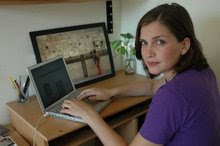
Tomorrow, I will leave the United States and my Jewish-American community and move to Israel for the year. Nervous that being a Jew in Israel may taste too sweet for me to ever return, I decided to get one last taste of American Jewry by spending my day in New York City at the
The Jewish Museum.
This month the museum is featuring an exhibit entitled, "Dateline Israel: New Photography and Video Art." Before I stepped onto the New York City pavement, I was able to view the
exhibit online. The stunning web display revved my already boiling enthusiasm and provoked further excitement for the adventure to the museum that lay ahead.
The following morning, my brother Mick and I left his comfortable suburban house in Commack, Long Island and began the journey to New York. Many miles, a subway ride and museum entrance fee later, Mick and I entered the exhibit. Although Mick had not scanned the website and found the exhibit to be fresh and engaging, I was surprised to find that I had spent time and money to view essentially the same exhibit that I had viewed online.
Nearly all of the pieces that were displayed elegantly on the walls were also posted to the website in a easy to view slide show. Every caption that provided more detail about the artwork was on the website as well. The greatest advantage to stepping inside the museum and paying the fee was that all of the video footage could be seen and that the guards were uniquely friendly and inquisitive.
The staleness of my physical experience with this exhibit raisesmany questions about the museum galleries of the future. By searching "Museums and Websites" on Google, I was able to find a few websites that keep lists of museums' websites. However, I was distressed to not find any discussion of the differences between physical and virtual galleries. Will Internet galleries take the place of museums? Will we pay a fee to enter a website and browse highly interactive curated web pages? Are webmasters the new curators?
In the end, I found myself wanting to believe that the websites overly thorough display was a kind gesture by the curators at The Jewish Museum who were more interested in educating the public than attracting people to the museum who would pay an entrance fee.
Clearly the trip was still a fruitful adventure, provoking questions about the way museums are using their websites and the future of curatorial work. Additionally, I was able to visit the two floors of permanent exhibition that I had not visited online. However, most importantly, I was able to say goodbye to the
land where "All men are created equal" and the
land where the Jewish people have lived and practiced their religion freely for generations -- America.
See you later American Jewry... To Israel my friends!






